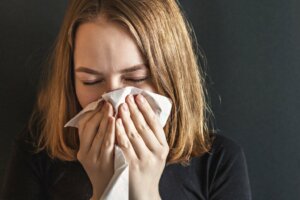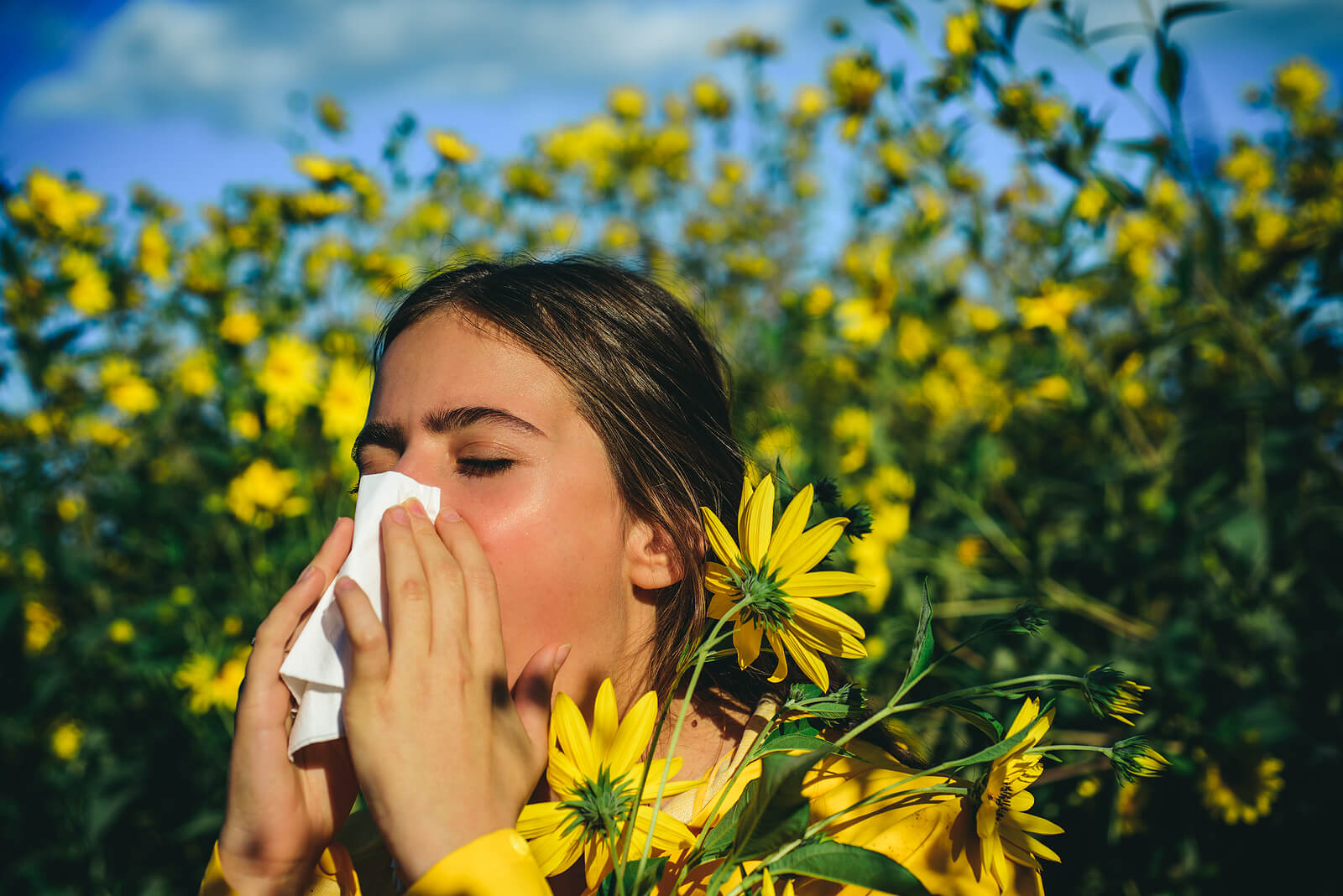Ragweed Allergy: Everything You Need to Know

For many allergy sufferers, spring is the most dreaded season. However, some allergens are present during other seasons of the year, such as ragweed pollen. Ragweed allergy causes thousands of cases of rhinitis annually, and its prevalence is spreading rapidly throughout the world.
Ragweed is a weed that grows in dry places on the American and European continents. It’s one of the main culprits of allergic reactions, due to the ease with which it develops and the amount of pollen it secretes. Today we’ll show you everything you need to know about it, including some tips to minimize exposure.
What’s ragweed allergy?

Allergic reactions to ragweed occur when the patient comes into contact with the pollen of this weed. Unlike other plants, and as Asthma and Allergy Foundation of America points out, its flowers reach maturity between summer and autumn.
During these seasons, pollen is released between 10 am and 3 pm and can travel hundreds of kilometers thanks to high winds.
According to researchers, ragweed is the third most common allergen, with sensitization rates ranging from 26% in the United States to 45% in Canada. Its expansion to new territories is advancing rapidly.
This is due, according to studies, to climate change, because the plant can now grow in areas that previously had a colder climate.
In short, we can point out the following characteristics of an allergy to ragweed:
- It’s most common during the month of September.
- It reaches its highest point at 12:00 pm
- Pollen can travel more than 500 kilometers through air currents.
- A high percentage of the population is sensitive to it.
- The plant, although native to North America, has spread to almost all regions of the world.
Ragweed allergy is also called ragweed hay fever. The condition is linked to some food allergies, through a condition called oral allergy syndrome. This is a type of cross-reaction in which the body isn’t able to distinguish the protein in pollen from the pollen in certain foods (they’re very similar).
When this happens, it reacts in the same way as it would when faced with the pollen of the plant. In this way, you can experience allergy symptoms when eating melon, sunflower seeds, banana, and watermelon, among others. This only happens in patients with sensitivity to this herb.
What are the symptoms of a ragweed allergy?
As the American College of Allergy, Asthma & Immunology points out, allergic reactions due to contact with plant pollen aren’t distinguished from other types of sensitivities. You can experience the following:
- Nasal congestion
- Sneezing
- Eye irritation
- Inflammation
- Runny nose
- Itch
- Wheezing
- Cough
If you have developed oral allergy syndrome, you’ll experience a swelling of the lips, tongue or throat accompanied by itching. In rare cases, you could develop a severe anaphylactic reaction.
This syndrome can also be caused by birch pollen and grass, so it’s important to find its exact cause.
How is a ragweed allergy treated?
Ragweed allergy has several treatment options, which include lifestyle changes and medication. We’ll talk about the first ones in the next section, but now we’ll consider the drugs that can be used to counteract a reaction. We highlight the following:
- Antihistamines: This is the main treatment to reverse the effects of a reaction. Its function is to block the production of histamine, the substance that your body secretes due to hypersensitivity.
- Corticosteroids: These are used as a method to reduce inflammation in the affected areas. Its most common administration is through tablets or decongestants, although they must be used with care because they can cause irritation. Because of this, they’re recommended in moderate or severe cases.
- Immunotherapy: Immunotherapy consists of desensitizing patients so that their body doesn’t react as it does in the presence of pollen. To do this, tablets or vaccines with allergen compounds are used. Studies and research support its use as a preventive therapy.
It isn’t uncommon for allergists to recommend taking some drugs or vaccines before the high-risk season for ragweed begins. Consult with your specialist feel you’re a needy case, and also if you’re a candidate for immunotherapy sessions.
Tips for allergic patients

Apart from following the treatment, you must include a series of habits to reduce exposure. Among the most important changes you can make, we highlight the following:
- Avoid going out during hours of increased pollen exposure in the ragweed months.
- Consider purchasing a dehumidifier, a particulate air filter for your home.
- Keep windows closed during pollen release season.
- Keep the air conditioning on inside the residence and in the car to avoid the accumulation of the allergen.
- Don’t dry your clothes in the open air, it could attract pollen particles.
- Consider vacationing, if possible, to areas less likely to affect you. Do this if your reactions are particularly strong.
- Vacuum the house regularly.
- Wear glasses and a mask if you have to go out during the pollen season.
Also, always remember to carry an epinephrine injection if you’re prone to having anaphylactic attacks. Although they’re rare, consult with the specialist about your chances of developing and how to use the injection when the time comes.
You can also wear necklaces or bracelets that alert others to the fact that you’re an allergic person. The most important thing to do is avoid the allergen, as well as the foods that your body can mistake for it. For greater precision, consult a specialist to determine your entire spectrum of sensitivity to triggers.
For many allergy sufferers, spring is the most dreaded season. However, some allergens are present during other seasons of the year, such as ragweed pollen. Ragweed allergy causes thousands of cases of rhinitis annually, and its prevalence is spreading rapidly throughout the world.
Ragweed is a weed that grows in dry places on the American and European continents. It’s one of the main culprits of allergic reactions, due to the ease with which it develops and the amount of pollen it secretes. Today we’ll show you everything you need to know about it, including some tips to minimize exposure.
What’s ragweed allergy?

Allergic reactions to ragweed occur when the patient comes into contact with the pollen of this weed. Unlike other plants, and as Asthma and Allergy Foundation of America points out, its flowers reach maturity between summer and autumn.
During these seasons, pollen is released between 10 am and 3 pm and can travel hundreds of kilometers thanks to high winds.
According to researchers, ragweed is the third most common allergen, with sensitization rates ranging from 26% in the United States to 45% in Canada. Its expansion to new territories is advancing rapidly.
This is due, according to studies, to climate change, because the plant can now grow in areas that previously had a colder climate.
In short, we can point out the following characteristics of an allergy to ragweed:
- It’s most common during the month of September.
- It reaches its highest point at 12:00 pm
- Pollen can travel more than 500 kilometers through air currents.
- A high percentage of the population is sensitive to it.
- The plant, although native to North America, has spread to almost all regions of the world.
Ragweed allergy is also called ragweed hay fever. The condition is linked to some food allergies, through a condition called oral allergy syndrome. This is a type of cross-reaction in which the body isn’t able to distinguish the protein in pollen from the pollen in certain foods (they’re very similar).
When this happens, it reacts in the same way as it would when faced with the pollen of the plant. In this way, you can experience allergy symptoms when eating melon, sunflower seeds, banana, and watermelon, among others. This only happens in patients with sensitivity to this herb.
What are the symptoms of a ragweed allergy?
As the American College of Allergy, Asthma & Immunology points out, allergic reactions due to contact with plant pollen aren’t distinguished from other types of sensitivities. You can experience the following:
- Nasal congestion
- Sneezing
- Eye irritation
- Inflammation
- Runny nose
- Itch
- Wheezing
- Cough
If you have developed oral allergy syndrome, you’ll experience a swelling of the lips, tongue or throat accompanied by itching. In rare cases, you could develop a severe anaphylactic reaction.
This syndrome can also be caused by birch pollen and grass, so it’s important to find its exact cause.
How is a ragweed allergy treated?
Ragweed allergy has several treatment options, which include lifestyle changes and medication. We’ll talk about the first ones in the next section, but now we’ll consider the drugs that can be used to counteract a reaction. We highlight the following:
- Antihistamines: This is the main treatment to reverse the effects of a reaction. Its function is to block the production of histamine, the substance that your body secretes due to hypersensitivity.
- Corticosteroids: These are used as a method to reduce inflammation in the affected areas. Its most common administration is through tablets or decongestants, although they must be used with care because they can cause irritation. Because of this, they’re recommended in moderate or severe cases.
- Immunotherapy: Immunotherapy consists of desensitizing patients so that their body doesn’t react as it does in the presence of pollen. To do this, tablets or vaccines with allergen compounds are used. Studies and research support its use as a preventive therapy.
It isn’t uncommon for allergists to recommend taking some drugs or vaccines before the high-risk season for ragweed begins. Consult with your specialist feel you’re a needy case, and also if you’re a candidate for immunotherapy sessions.
Tips for allergic patients

Apart from following the treatment, you must include a series of habits to reduce exposure. Among the most important changes you can make, we highlight the following:
- Avoid going out during hours of increased pollen exposure in the ragweed months.
- Consider purchasing a dehumidifier, a particulate air filter for your home.
- Keep windows closed during pollen release season.
- Keep the air conditioning on inside the residence and in the car to avoid the accumulation of the allergen.
- Don’t dry your clothes in the open air, it could attract pollen particles.
- Consider vacationing, if possible, to areas less likely to affect you. Do this if your reactions are particularly strong.
- Vacuum the house regularly.
- Wear glasses and a mask if you have to go out during the pollen season.
Also, always remember to carry an epinephrine injection if you’re prone to having anaphylactic attacks. Although they’re rare, consult with the specialist about your chances of developing and how to use the injection when the time comes.
You can also wear necklaces or bracelets that alert others to the fact that you’re an allergic person. The most important thing to do is avoid the allergen, as well as the foods that your body can mistake for it. For greater precision, consult a specialist to determine your entire spectrum of sensitivity to triggers.
- Creticos PS, Maloney J, Bernstein DI, Casale T, Kaur A, Fisher R, Liu N, Murphy K, Nékám K, Nolte H. Randomized controlled trial of a ragweed allergy immunotherapy tablet in North American and European adults. J Allergy Clin Immunol. 2013 May;131(5):1342-9.e6.
- El-Qutob D. Vaccine development and new attempts of treatment for ragweed allergy. Ther Adv Vaccines. 2015 Mar;3(2):41-7.
- Oswalt ML, Marshall GD. Ragweed as an example of worldwide allergen expansion. Allergy Asthma Clin Immunol. 2008 Sep 15;4(3):130-5. doi: 10.1186/1710-1492-4-3-130.
- Richter, R., Berger, U. E., Dullinger, S., Essl, F., Leitner, M., Smith, M., & Vogl, G. Spread of invasive ragweed: climate change, management and how to reduce allergy costs. Journal of Applied Ecology. 2013; 50(6): 1422-1430.
Este texto se ofrece únicamente con propósitos informativos y no reemplaza la consulta con un profesional. Ante dudas, consulta a tu especialista.







